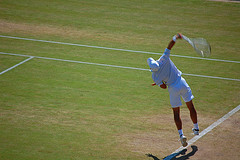INTRODUCTION
Are you interested in the world of elite tennis physiotherapy? If you manage athletes who play tennis and/or would like to move to the level of elite tennis physiotherapy then you will be interested in what ATP Sports Physiotherapist Paul Ness has to say in this interview. He has been kind enough to take the time to answer the following questions so you guys can learn what it takes and give some advice about how to get where he is!
1. Tell us about your career pathway to date and how you got to where you are today?
I graduated from LaTrobe University at the end of 1991 and found a number of jobs in private practice over the next few years. I then did my post graduate diploma in Sports Physiotherapy 1995-6. After finishing my studies I was offered a job at the Australian open working for tennis Australia for the qualifying week and two weeks of main draw. I worked for the Australian open for seven years and was then approached by one of the ATP physiotherapists and was offered part-time contract work.
2. How did you become involved with the ATP World Tour?
The job with the ATP world tour was more or less through word-of-mouth. I started with about eight tournament weeks in the first year and then worked usually between 12 and 15 weeks for the next five or six years. During this time I was still working in practice at home. At the end of 2008 I was offered a full-time position with the ATP world tour and have been working full time for the tour ever since.
3. You have travelled with the ATP around the world to Wimbledon, Toronto and Cincinatti Masters and have recently worked at the Australian Open. How often are you away from home?
A full-time position as physiotherapist with the ATP consists of 22 working weeks. Given that I always work the Australian Open, which is a three-week tournament, I am away from home for 19 weeks each year.
4. What is involved in an average day away on tour?
The average day on tour starts 60 to 90 minutes before start of play and goes through until end of play or shortly after depending on treatments you may need to do after the last match. For some of the bigger day and night session tournaments this means you may start work at about 9 AM and not finish until 11 or 12 PM, so the days can be quite long. Other tournaments, such as grass tournaments, do not have night sessions so the working day is generally shorter.
It is not uncommon to work a string of events in a row which might mean that you work anywhere from 14 to 28 days in a row. Lots of days in a row and lots of hours in a day can be fatiguing, but you know you can have a week or two off after finishing a string of events.
5. What advice would you give to those physiotherapist who want to pursue a career with elite tennis?
To be involved that tennis at the highest level these days usually means that you have to do is start at the Challenger or ITF events which are usually run by the local federations. These events are great to work as you get a good background in common tennis injuries and the feel for the sport especially with respect to doing court calls.
Then it can be a matter of luck or being in the right place at the right time, and knowing that a position has become available at the ATP level. Generally the managers of our group will look for someone with solid tennis experience and also someone who can work well in a team.
6. In elite level tennis players what are the main conditions you see; overuse injuries?
- Lower back injuries are statistically highest in number in tennis. There are huge torsional forces that go through the spine during the tennis strokes from serve to forehand to backhand.
- The next most common injury is of the shoulder. There are large acceleration and deceleration forces through the rotator cuff muscles and it is quite common to develop some tendon injuries especially if the player loses internal rotation of that shoulder.
- Knees are also prone to overload given the amount of lunging, decelerating, accelerating and twisting that takes place on the tennis court.
- We also see a wide variety of other upper and lower limb injuries; which certainly keeps the job interesting.
7. Finally, what are your top tips for the successful and timely rehabilitation of the injured tennis player?
- Education is one of the most important things. One of the biggest things is to help the player understand their injury; so they understand why we give them the rehabilitation exercises we do.
- Prevention is also key for tennis players. We try to implement extensive core training to help lower back and abdominal injuries and this will also set a good base for the lower limb.
- Flexibility. It is also essential for the player to maintain adequate flexibility of the shoulder, mostly into internal rotation, and a good strengthening programme for the rotator cuff to manage the loads that must go through the shoulder. Excellent calf and quadriceps strength and flexibility it is also important to help prevent tendon injuries.
- Early Intervention; it is very important that we have players manage their injuries early, before they become significant problems.
See Paul In Action
Photo Credit: Marc Di Luzio
I hope that you got something out of this interview. If you did be sure to let me know in the comments or catch me on Facebook or Twitter
If you require any sports physiotherapy products be sure check out PhysioSupplies (AUS) or MedEx Supply (Worldwide)
Related Posts
Comments











Hi! Great article, very interesting work! I’d like to know how a sports physiotherapist can become affiliated to ATP. Thanks.